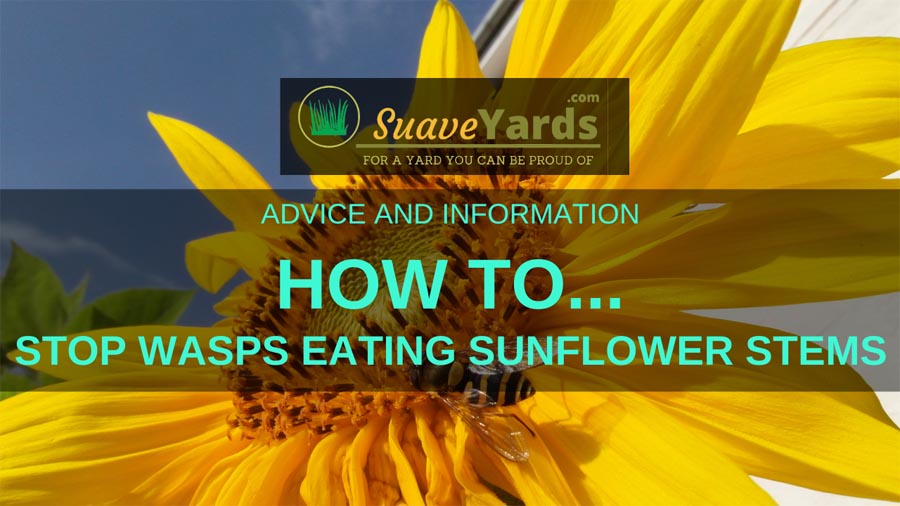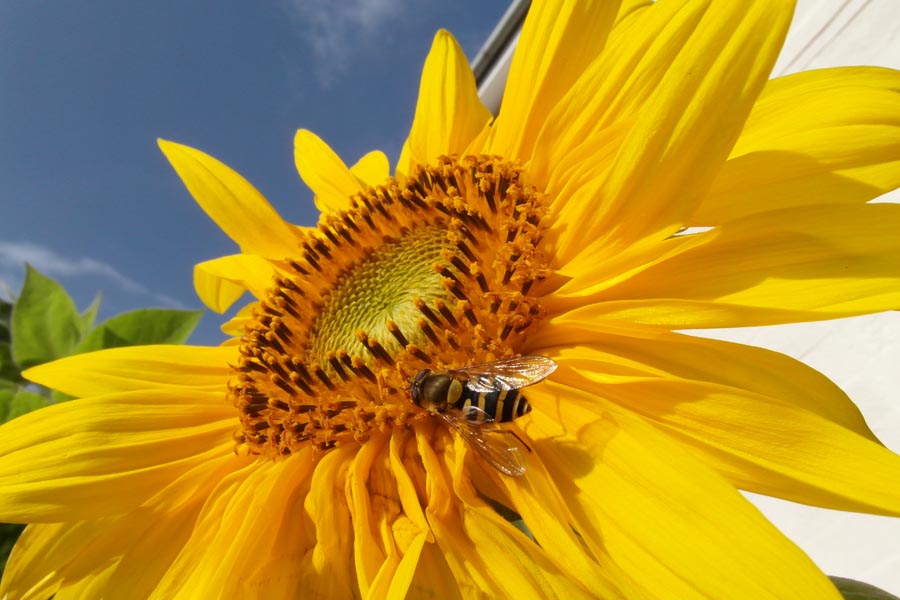
Sunflowers are very popular garden plants and with their long stems and the proliferation of color they add to a yard, rightly so.
But, they aren’t without their problems.
One query people are always searching for an answer to is how to stop wasps eating sunflower stems?
The good news is there are several ways to counter this problem and stop your prized sunflowers from being cut down before they have even started to grow.
So let’s take a closer look.
How To Stop Wasps Eating Sunflower Stems?
The quickest and easiest way to stop wasps from eating sunflower stems is to coat the stem in something unappealing to wasps like vaseline or spicy curry powder. You can also try mixing peppermint oil with water and dish soap and spraying that on or around your sunflowers, as peppermint oil is a natural wasp repellent. You should also take steps to make your garden as a whole less appealing to the insect.
Why Do Wasps Like Sunflower Stems?
Let me start quickly by answering another age-old question, why do wasps like sunflowers so much?
It may (or may not) be some consolation to know that there is a reason wasps like the stems of sunflowers so much, they provide a much-needed key ingredient to help them build strong and healthy nests.
The stems of sunflowers are rich in cellulose content and wasps use this cellulose as a starting point to create their homes. As the wet cellulose fibers dry, they form a strong paper base from which they can suspend their nest.
Let’s find out how to keep wasps away from your sunflowers.
1. Make Your Garden Less Attractive To Wasps

The first step towards stopping wasps from eating your sunflower stems is to make your garden, as a whole, a less attractive proposition for these insects.
You will never stop wasps coming into your garden completely, and you wouldn’t want that either as they do actually play an important ecological role. They help pollinate plants and get rid of other pests.
RELATED ===> How Much Water Does a Sunflower Need a Day?
If you find you have lots of wasps in your garden there are likely two main reasons:
- They can get food there
- They can get water there.
There is a third reason, that they have a nest in your garden, but we will deal with that later.
Be aware of the amount of water in your garden, as wasps love that. If you use sprinklers, try not to keep them on too long, and fix the direction so they don’t spray the pavement, which wasps also like.
Don’t leave food outside, whether that be your food or your pet’s food.
On top of that wipe down your table after you eat and make sure your rubbish sacks are sealed properly.
Food of course takes another form for wasps, fellow insects. They particularly enjoy things like aphids, ants and flies.
If you see wasps hanging around a plant with no flowers it is likely they are feasting on insects there. Treat the plant for these insects and the wasps will soon stop frequenting them.
A final way to reduce the number of wasps in your garden is to plant flowers that wasps don’t like, namely:
- Red flowers. Wasps don’t like the color red.
- Marigolds. Well known for being particularly pungent, wasps don’t like the smell.
- Roses. Being double-flowered, wasps find them too hard to access.
- Geraniums. Wasps don’t like them as they don’t produce much nectar.
- Jasmine and Evening Primrose. These flowers bloom in the evenings and wasps are not a fan.
2. Get Rid Of Their Nests
We briefly mentioned above that if you are seeing a lot of wasps in your garden, they could have their nest there.
This obviously isn’t something you want.
Remember wasps tend to build their nests in sheltered spots, with prime spots being under eaves, underneath windowsills, in bird boxes and in sheds or garages.
If you locate their nest, you can use a professional pest control firm to get rid of it for you, this is particularly advised when the nest is in a wall or underground.
If you are feeling confident you can try and get rid of the nest yourself, just be aware of the risks.
The best time to try and do this is at night (make sure you have a good torch!).
Spray the nest with a dedicated product such as Raid. It usually takes around 24 hours to coat the nest and work its way inside.
For good measure, spray it again the next day and then, after you remove the nest, spray the area where the nest was.
If you are feeling particularly confident you can even try placing a cloth bag over the entire nest and tying it off at the top.
Pull the nest free and drop it in a large pail of water, and make sure it remains submerged.
RELATED ===> Can You Grow Beans Up Sunflowers?
3. Hang A Dummy Nest Near Your Sunflowers
Wasps are highly territorial insects and won’t make a nest close to another colony.
You can buy dummy wasp nests to hang near your sunflowers or you can make your own. If you decide to make your own you can do it quickly and without spending much money as shown in the video below:
This will hopefully deter wasps from staying too long around your prized sunflowers.
4. Coat The Stem Of The Sunflower

If you have tried everything to make your garden as unappealing to wasps as possible and you still have the problem of them eating your sunflower stems, then it is time to tackle the problem head-on.
Cover the stems of the sunflower in something wasps don’t like.
Prime contenders are something spicy like a curry powder, or something slippery and easy to apply like vaseline or washing up liquid.
You could even try wrapping the stems in tin foil
Now I have to put my hands up and admit I haven’t tried these methods myself, but they did crop up more than once when I was doing research into how to tackle the problem.
5. Use Peppermint Oil
Peppermint oil has been shown to be a natural wasp repellent.
By mixing a few drops of peppermint oil, with a few tablespoons of dish soap and some water you have a ready-made wasp repellent.
RELATED ===> Will Ants Kill My Sunflowers?
Shake the mixture well and then either spray it on a nest or on the stem itself.
It sounds nasty but as well as wasps not liking the peppermint oil, the soap will clog up the wasps breathing pores.
6. Create A Wasp Trap

Another DIY solution is to create your own wasp trap to hang near your sunflowers.
The great thing about this is how simple it is to construct, and the fact it uses materials nearly every household will already have.
All you need is a knife, a two-liter soda bottle, something to hang the trap up with and something to use as bait.
Unscrew the cap and cut the top off of the soda bottle, just below where it tapers in. Set this to one side to use again later.
Then put your bait into the bottom of the bottle. Sweet foods like jam, fruit juice and sugar are good options, but you can consider something savory like tuna. This will attract wasps and yellow jackets, but not honeybees as they will be looking for something sweet.
Then take the top of the bottle you cut off earlier, flip it upside and place it inside the bottom portion of the bottle. The cap should be facing down towards the bait in the bottom half of the bottle.
You can then hang the trap up near your sunflowers.
Wasps will pick up on the scent of the bait, fly down to get to it, but then not be able to get back out.

Final Thoughts

As you can see there are a number of ways to alleviate the likelihood of wasps eating your sunflower stems.
Reducing the attraction of your garden as a whole to the wasp population is your first step to solving the problem, and also probably making your garden a much more pleasant place to spend time!
If there is a nest in or around your garden you also need to decide how to tackle that. Caution is always advised.
The most direct way of stopping them from getting to the stems is to coat the stems in something horrible, something even wasps won’t like.
Do remember that as annoying as they can be though, wasps do have an important role in the environment.
They prey on other insects and control the number of other potential pests.
So whilst we may think the world would be a better place without wasps, it would mean many more pests on our flowers and in our gardens.
But for now at least you know how to stop them eating your sunflower stems!


These wasp were 2″ long, glossy black with 3 yellow bands. Are these common on sunflowers?
They sound like they might be Northern Giant Hornets. Where are you located Katherine?